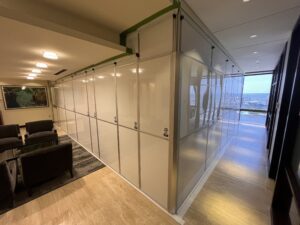ICRA 101: A Contractor’s Guide to Infection Control in Healthcare Construction
Renovating or constructing in healthcare environments is no ordinary task. The stakes are high—not just for the project’s success, but also for protecting the health of vulnerable patients and medical staff. This is where ICRA (Infection Control Risk Assessment) comes into play.
For contractors stepping into the world of healthcare construction, understanding and implementing ICRA is non-negotiable. This guide will walk you through the fundamentals of ICRA, its importance in healthcare spaces, and the solutions contractors can leverage to meet infection control requirements effectively and efficiently.
What is ICRA?
The Infection Control Risk Assessment (ICRA) is a standardized framework designed to minimize the risk of infections during construction, renovation, or maintenance activities in healthcare facilities. Its goal is to contain airborne particles, dust, and pathogens that may otherwise compromise patient safety.
Created and regulated by organizations like the CDC and FGI (Facility Guidelines Institute), ICRA provides contractors with guidelines for identifying and mitigating potential infection risks before a project begins.
Key components of ICRA include:
- Determining the scope of work
- Identifying potential risks to patients and medical staff
- Establishing appropriate containment and infection control measures
- Monitoring and documenting compliance throughout the project
When followed correctly, ICRA ensures construction activities can proceed safely, without impacting healthcare operations or exposing vulnerable individuals to unnecessary risk.
How is ICRA Used in Hospitals and Healthcare Spaces?
Healthcare facilities are highly sensitive environments, even under normal circumstances. Construction or renovation projects in these spaces introduce additional risks, such as:
- Airborne contaminants from construction dust
- Pathogen exposure through building materials
- Noise disruption impacting patient recovery
- Airflow changes causing the spread of harmful particles
ICRA integrates infection control into every phase of the construction project. Here’s how it typically works:
- Pre-Project Risk Assessment
Before construction begins, an ICRA evaluation identifies potential risks based on the project scope, type of facility, and patient population. For example, a project near a neonatal intensive care unit (NICU) may require higher containment measures than a project in an administrative area.
- Containment Planning
Based on the nature of the risks identified, specific mitigation strategies are outlined, including barriers, HEPA filtration, and negative air pressure systems.
- Ongoing Monitoring
Throughout the project, contractors must monitor and maintain compliance with ICRA standards. This includes regular inspections of containment systems, airflow testing, and documentation.
By addressing risks upfront, ICRA ensures construction activities can be carried out safely while maintaining the integrity of the healthcare environment.
Different Levels of ICRA Classifications
ICRA relies on a classification system to determine the infection control precautions required for a specific project. These classifications take into account:
- Patient risk groups (e.g., immune-compromised patients or general occupancy)
- Type of activity (e.g., ceiling tile replacement, demolition, or major structural work)
ICRA levels range from low (minimal precautions) to high (comprehensive controls), such as:
- Class I: Activities that create no dust, such as painting or non-hazardous maintenance work.
- Class II: Minor activities involving minimal dust, such as drilling into walls. Basic barriers and cleaning measures suffice.
- Class III: Work generating moderate dust (e.g., demolishing small sections of walls) near moderate-risk patient areas. Higher containment standards, like HEPA filters and sealed barriers, are required.
- Class IV: High-dust activities (e.g., demolition of large areas) in or near high-risk patient areas. This requires full containment, including negative air pressure systems and continuous monitoring.
Healthcare facilities typically work with contractors to classify projects based on these levels, ensuring infection control measures are matched to the specific risks.
What are the Containment Needs for an ICRA Space?
Effective containment is at the heart of ICRA compliance. Without control over airborne contaminants and dust, construction activities pose a direct threat to patient safety. Here’s an overview of the primary containment needs in an ICRA space:
1. Temporary Barriers
Physical barriers, such as solid walls or partitions, isolate the construction zone from adjacent healthcare spaces. Barriers should:
- Be sealed at all joints to prevent air leaks
- Extend from floor to ceiling
- Include air-tight doors or construction vestibules
2. Negative Air Pressure
Negative air pressure ensures airborne contaminants are pulled into the construction zone instead of escaping. Specialized equipment, like HEPA-filtered air scrubbers, is used to create consistent airflow management.
3. Dust Suppression
HEPA vacuum systems, tacky mats at entry/exit points, and dampening techniques (like misting) help control the spread of dust and debris.
4. Air Filtration
Air scrubbers equipped with HEPA filters clean the air within the containment area, capturing 99.97% of airborne particles.
5. Access Control
Limiting access to construction areas—with clearly designated entry/exit points for authorized personnel only—is crucial to maintaining containment integrity.
By addressing these containment needs, contractors can ensure their work complies with ICRA standards while keeping healthcare environments safe.
How Temporary Wall Systems Satisfy ICRA Requirements
Traditional containment methods, like plastic sheeting or drywall, often fall short in meeting modern ICRA standards. Temporary Wall Systems provide a superior, compliant solution that simplifies the process for contractors and healthcare facilities alike.
Here’s why Temporary Wall Systems are an ideal choice for ICRA spaces:
Effortless Installation and Removal
Temporary Wall Systems are designed as modular, reusable panels that can be delivered, installed, and removed seamlessly by trained technicians. This eliminates the need for messy construction and reduces setup time significantly.
Airtight Seals and Durability
These walls provide a strong, non-porous seal that prevents air leaks, ensuring effective containment. Unlike plastic barriers, they’re durable, professional, and easy to clean.
Customizable and Flexible
Temporary Wall Systems are highly adaptable to a project’s specific needs. Adjustable heights, integrated doors, and compatibility with negative air solutions make them a versatile choice for healthcare projects of all sizes.
Compliant with ICRA Standards
Our walls meet or exceed ICRA compliance requirements, offering reliable solutions for Class III and IV projects. You can trust that your containment measures are up to code.
Sustainable and Cost-Effective
Made from reusable materials, Temporary Wall Systems are not only environmentally friendly but also help reduce long-term costs compared to low-quality disposable barriers.
By selecting Temporary Wall Systems, contractors can focus on completing projects efficiently while providing healthcare facilities with peace of mind.
Build with Confidence in Healthcare Spaces
ICRA is more than an infection control measure; it’s a commitment to patient safety in the unique and demanding environment of healthcare construction. By understanding ICRA frameworks, implementing proper containment strategies, and utilizing solutions like Temporary Wall Systems, contractors can deliver high-quality projects while safeguarding health.
Are you planning a healthcare renovation or construction project? Temporary Wall Systems provides full-service solutions designed to meet ICRA compliance with ease. From delivery and installation to removal, our modular walls simplify every step of the process, letting you focus on what matters most.
Contact us today to learn more about Temporary Wall Systems and how we can assist with your next infection-controlled project.


